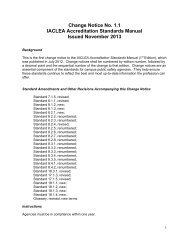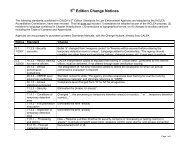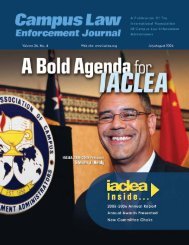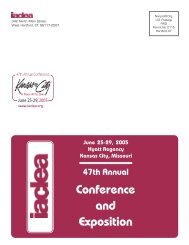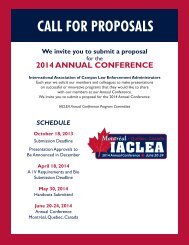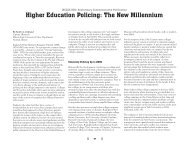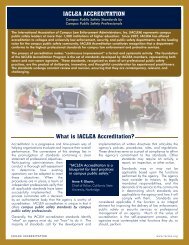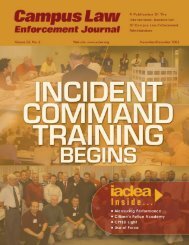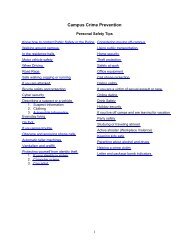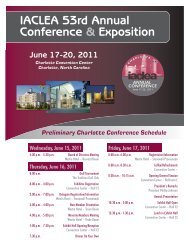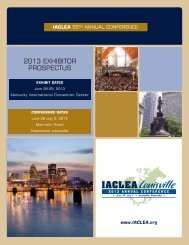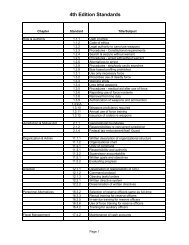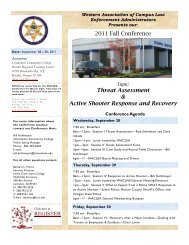Volume 36, No. 2 - March/April 2006 Campus Law ... - IACLEA
Volume 36, No. 2 - March/April 2006 Campus Law ... - IACLEA
Volume 36, No. 2 - March/April 2006 Campus Law ... - IACLEA
You also want an ePaper? Increase the reach of your titles
YUMPU automatically turns print PDFs into web optimized ePapers that Google loves.
The Distance from Probable Cause to Reasonable Doubt<br />
Continued from page 31<br />
Our deliberations lasted about 45 minutes<br />
or so, and in the end, we all had the same<br />
basic point of view. We all believed the<br />
defendant “did it,” because it seemed<br />
unlikely a person would admit driving the<br />
car unless he had. However, it was possible<br />
he was confused when he spoke; and there<br />
was no “evidence,” other than his<br />
statement, to show he was the driver.<br />
he said, was based on the fact that the<br />
first person to be thrown out of the<br />
driver’s door (which had been thrown<br />
open by the crash) would have been the<br />
driver who would have been thrown in<br />
the direction the door was facing at the<br />
time of impact. Since Jeremy had landed<br />
in a direct line with this theory, he believed<br />
Jeremy had been the driver. He<br />
said the defendant would have been the<br />
second person thrown out of the car, landing<br />
where he did because the car was<br />
spinning around the pole after the car hit<br />
it. The prosecutor tried to get the witness<br />
to change his story, but he repeated<br />
that it was “scientifically, the most likely”<br />
scenario.<br />
The defendant did not testify.<br />
The Closing Statements: The defense<br />
attorney reviewed the evidence<br />
with the jury, asking us to make our decision<br />
based primarily on the “scientific<br />
evidence,” specifically, the theory provided<br />
by his expert witness. He also talked<br />
about the fact that after the accident, his<br />
client was confused and hurt; and at the<br />
hospital, he had been put on medications<br />
— he obviously wasn’t thinking clearly<br />
or making accurate statements. Reminding<br />
us that he and the defendant agreed<br />
with most of the trial testimony, the attorney<br />
told us he had presented expert<br />
testimony that contradicted the assertions<br />
made by the State. This was, he said, “reasonable<br />
doubt” that his client was driving,<br />
and we therefore had to find him innocent<br />
of the charges against him.<br />
“Use your common sense,” the prosecutor<br />
told us. The defendant admitted<br />
twice that he was the driver, and it seemed<br />
“convenient” that he would now recant<br />
his earlier statements. She repeated this<br />
several times, asking the jury to think<br />
about what the defendant had said, what<br />
the State Police Trooper believed, and<br />
that a young man had died due to the<br />
defendant’s reckless actions. He should<br />
be found guilty, she urged.<br />
Come learn some new tricks…<br />
… at the 16 th Annual IPMBA Conference<br />
An international event for public safety personnel on bikes<br />
May 6-13, <strong>2006</strong> ~ Dayton, Ohio, USA<br />
www.ipmba.org<br />
Call: 410-744-2400 ~ Email: info@ipmba.org ~ Visit: www.ipmba.org<br />
The Judge’s Charge: The next 45<br />
minutes or so was taken up with the judge<br />
explaining each of the charges again, including<br />
each of the elements needed to<br />
support the charge. He also gave us a<br />
primer on the concept of “reasonable<br />
doubt,” and explained that under the law<br />
if we had reasonable doubt, we had to<br />
find the defendant not guilty. The “alternate”<br />
juror was then selected by lottery,<br />
the judge told us to go to the jury room<br />
to conduct our deliberations, and we left<br />
the courtroom.<br />
Deliberations: The alternate juror was<br />
put in a separate room and she did not<br />
participate in any of the deliberations or<br />
the verdict. <strong>No</strong>t sure exactly where to<br />
begin, we decided to review all the evidence,<br />
so we looked at all the pictures,<br />
went over the diagram of the accident<br />
scene, and talked about the testimony. I<br />
wasn’t convinced that Jeremy had to be<br />
the driver, and using a paperclip holder<br />
(the car) and pencil (the pole) I found in<br />
the room, I tried to reenact the accident<br />
as best I could. We all took part in my<br />
show and tell; but in the end, it was basically<br />
inconclusive. The officers’ testimony<br />
boiled down to the fact that the defendant<br />
had admitted driving the car, but<br />
there was no physical evidence, including<br />
that gathered by the State Police<br />
Trooper, that he was, indeed, the driver.<br />
Bumping into that evidence was, of<br />
course, the “scientific” evidence provided<br />
by the expert witness. According to him,<br />
Jeremy was the driver and his view certainly<br />
made some sense and was plausible.<br />
Our deliberations lasted about 45 minutes<br />
or so, and in the end, we all had the<br />
same basic point of view. We all believed<br />
the defendant “did it,” because it seemed<br />
unlikely a person would admit driving the<br />
car unless he had. However, it was possible<br />
he was confused when he spoke;<br />
and there was no “evidence,” other than<br />
his statement, to show he was the driver.<br />
In fact, any such evidence showed that<br />
Jeremy was “most likely” the driver, not<br />
the defendant. That was “reasonable<br />
doubt,” and we followed the law, finding<br />
the defendant not guilty.<br />
Continued on page 33<br />
32 / <strong>Campus</strong> <strong>Law</strong> Enforcement Journal



